The Electrochemistry Meters Market is estimated to be valued at USD 330.2 million in 2025 and is projected to reach USD 872.0 million by 2035, registering a compound annual growth rate (CAGR) of 10.2% over the forecast period.
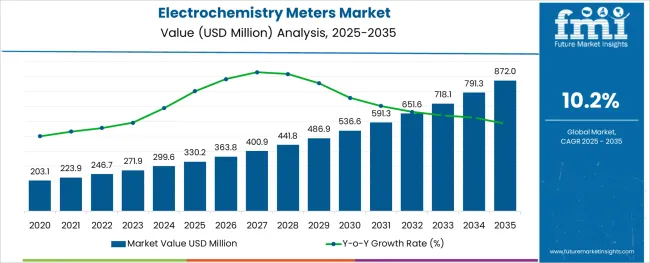
The electrochemistry meters market is growing steadily as laboratory and industrial processes increasingly depend on precise chemical measurements to maintain product quality and regulatory compliance. Scientific publications and industry discussions have emphasized the need for reliable testing of pH conductivity and oxidation-reduction potential in research and production environments.
The adoption of portable and benchtop meters has expanded across industries where water quality testing and chemical formulation play a critical role. In addition, product innovations have improved measurement accuracy while reducing calibration time supporting greater laboratory efficiency.
The demand for advanced electrochemical analysis tools continues to rise as biotechnology pharmaceutical and environmental testing sectors scale their operations. The future outlook remains positive as the market benefits from growing emphasis on process automation improved sensor technologies and the expanding role of analytical testing in quality assurance. Segmental leadership is expected from pH and ORP Meter in product type Potentiometry in technology type and Biotechnology and Pharmaceutical in end-use industry.
The market is segmented by Product Type, Technology Type, and End-use Industry and region. By Product Type, the market is divided into pH and ORP Meter, Conductivity Meter, Ion Concentration Meter, Dissolved Oxygen Meter, Potentiometric Titrators, and Pocket Testers. In terms of Technology Type, the market is classified into Potentiometry, Voltammetry, Coulometry, and Others. Based on End-use Industry, the market is segmented into Biotechnology and Pharmaceutical, Environmental Testing, Food and Agriculture, Academic Research Institutes, and Others. Regionally, the market is classified into North America, Latin America, Western Europe, Eastern Europe, Balkan & Baltic Countries, Russia & Belarus, Central Asia, East Asia, South Asia & Pacific, and the Middle East & Africa.
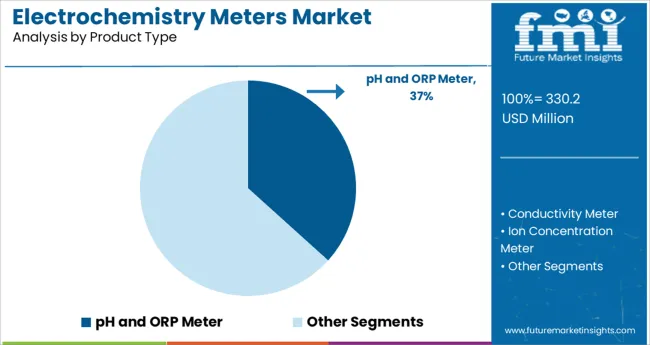
The pH and ORP Meter segment is projected to contribute 36.7% of the electrochemistry meters market revenue in 2025 maintaining its leading role in product adoption. Growth in this segment has been driven by the critical importance of pH and oxidation-reduction potential measurement in maintaining chemical stability and product integrity.
Laboratories and production facilities have relied on these meters to ensure optimal chemical environments for biological reactions and industrial processes. The versatility of pH and ORP meters across water treatment environmental testing and manufacturing quality control has strengthened their adoption.
Recent product improvements in sensor lifespan and calibration accuracy have enhanced their operational efficiency. As industries increasingly prioritize chemical balance and contamination control the pH and ORP Meter segment is expected to maintain strong demand.
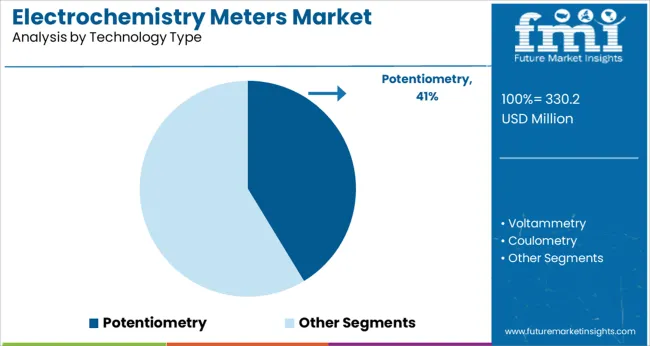
The Potentiometry segment is projected to hold 41.3% of the electrochemistry meters market revenue in 2025 establishing it as the most widely used technology. Potentiometry has gained prominence for its simplicity and effectiveness in measuring ion activity and solution potential without complex procedures.
Laboratories have favored potentiometric methods due to their accuracy in determining pH ion concentration and oxidation-reduction balance across diverse chemical environments. In addition this technology has been recognized for its compatibility with automated testing systems reducing manual effort and improving throughput in routine measurements.
The growing focus on real-time monitoring in production processes has further driven the adoption of potentiometry-based meters. As industries seek dependable electrochemical testing solutions the Potentiometry segment is expected to sustain its leadership across analytical applications.
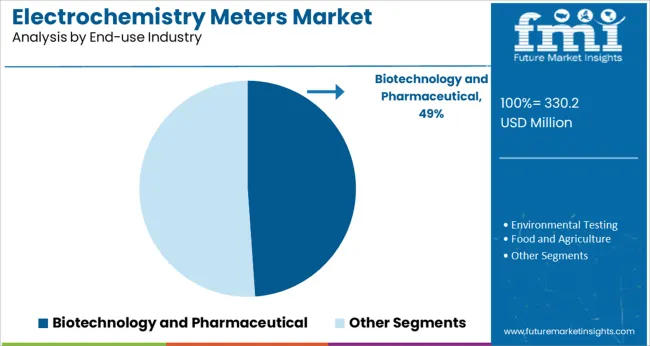
The Biotechnology and Pharmaceutical segment is projected to represent 48.9% of the electrochemistry meters market revenue in 2025 securing its position as the top end-use industry. Growth in this segment has been supported by the rising demand for precise chemical analysis in drug manufacturing cell culture monitoring and quality assurance processes.
Laboratories and production units in these industries have adopted electrochemistry meters to maintain stringent chemical conditions required for product efficacy and safety. The need for continuous monitoring of pH ionic concentration and redox potential in biologics and pharmaceutical formulations has driven consistent usage of these meters.
Additionally regulatory guidelines mandating strict quality control in drug development have further reinforced their adoption. As research and manufacturing activities expand the Biotechnology and Pharmaceutical segment is expected to remain the primary driver of electrochemistry meter demand.
The emergence of portable electrochemistry meters that are capable of lowering the equipment amount by showcasing multiple parameters in an individual display unit is set to boost growth. Portable meters can save the time required to transfer electrodes from one meter to another.
Industrial fields, such as scientific research, water quality checking, biological agriculture, environmental protection, and disease control are expected to witness high demand for the measurement of numerous parameters.
Increasing occurrence of chemical contamination of water with the inclusion of nitrogen, salts, pesticides, and metals is anticipated to foster the electrochemistry meters market growth in the evaluation period. Increasing need for safe water production among several water treatment companies for providing clean drinking water to the populace globally is another crucial factor that is expected to fuel growth.
Declining average selling prices of electrochemistry meters may hamper the market in future years. In addition to that, commoditization of electrochemistry instruments is projected to obstruct their sales in the forecast period.
However, increasing deployment of complex and new projects on the water industry and power plants is expected to necessitate the requirement of continuous monitoring of plants. It is further set to open doors to new growth opportunities for key players and propel sales of electrochemistry meters.
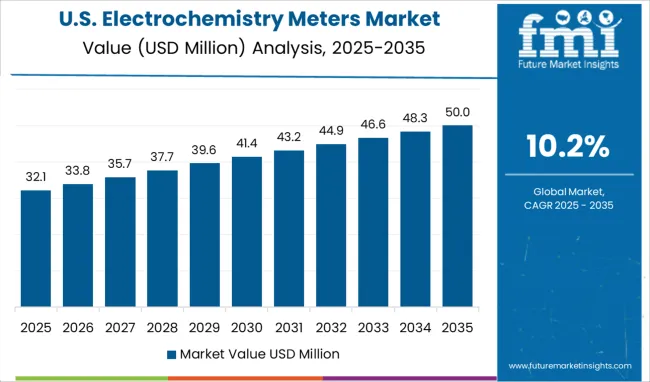
In terms of region, North America is anticipated to generate the largest electrochemistry meters market share in the forthcoming decade. Development in pharmaceutical and biotechnology industries, especially in the USA and Canada is expected to bolster the growth.
Increasing government support in terms of funding to trigger research work is another significant factor that would contribute to the market growth. Further, surging adoption of pH meters owing to increasing water pollution is likely to fuel growth.
Rapid industrialization and urbanization are leading to the excessive release of wastewater into water bodies by various factories, which would push growth. Increasing prevalence of diseases associated with the consumption of contaminated water is thus compelling key players to develop new pH meters across North America.
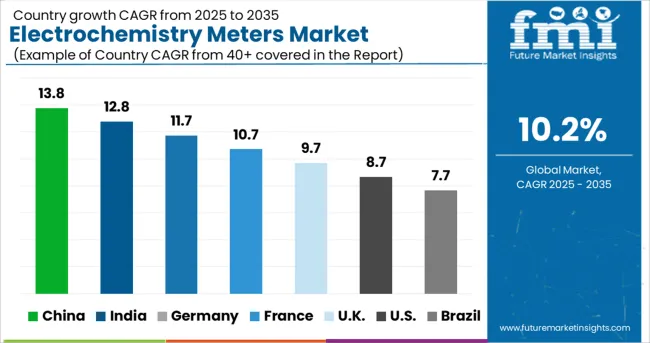
Increasing cases of water-borne diseases in developing countries, such as India and China are likely to propel the demand for electrochemistry meters across Asia Pacific. As per the India Water Portal, approximately 37.7 million people living in the country are affected by water-borne diseases every year.
Also, nearly 1.5 million children die because of diarrhea and about 73 million working days are lost due to the disease. These numbers are projected to increase in future years, thereby propelling the Asia Pacific market.
Moreover, contamination of rural piped supplies and groundwater backed by improper sanitation and hygiene is projected to drive the regional market. Fecal contamination is the most prevalent in low- and middle-income countries across Asia Pacific. Thus, key manufacturers are striving to introduce state-of-the-art pH meters to prevent waterborne diseases, which would aid growth.
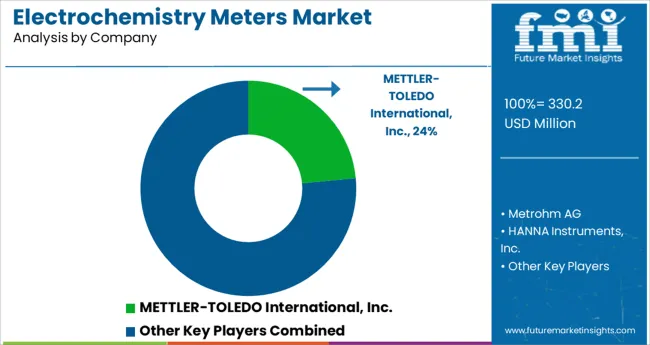
Some of the leading players operating in the global electrochemistry meters market include METTLER-TOLEDO International, Inc., Metrohm AG, Yokogawa Electric Corporation, Xylem Inc., Thermo Fisher Scientific, Inc., HANNA Instruments, Inc., Horiba Ltd., Danaher Corporation, DKK TOA Corporation, and Endress+Hauser AG among others.
Leading companies in the market are increasingly focusing on developing cutting-edge products to attract more customers and gain a competitive edge. They are also engaging in collaborations and partnerships with local firms to co-develop novel products and expand their geographic presence. A few other start-up companies are aiming to improve their portfolios by signing agreements with international players.
| Report Attribute | Details |
|---|---|
| Growth Rate | CAGR of 10.2% from 2025 to 2035 |
| Base Year for Estimation | 2024 |
| Historical Data | 2020 to 2024 |
| Forecast Period | 2025 to 2035 |
| Quantitative Units | Revenue in million and CAGR from 2025 to 2035 |
| Report Coverage | Revenue Forecast, Volume Forecast, Company Ranking, Competitive Landscape, Growth Factors, Trends and Pricing Analysis |
| Segments Covered |
Product Type, Technology Type, End-use Industry, Region |
| Regions Covered |
North America; Latin America; Western Europe; Eastern Europe; APEJ; Japan; Middle East and Africa |
| Key Countries Profiled | USA, Canada, Brazil, Argentina, Germany, UK, France, Spain, Italy, Nordics, BENELUX, Australia & New Zealand, China, India, ASEAN, GCC, South Africa |
| Key Companies Profiled |
METTLER-TOLEDO International, Inc.; Metrohm AG; Yokogawa Electric Corporation; Xylem Inc.; Thermo Fisher Scientific, Inc.; HANNA Instruments, Inc.; Horiba Ltd.; Danaher Corporation; DKK TOA Corporation; Endress+Hauser AG |
| Customization | Available Upon Request |
The global electrochemistry meters market is estimated to be valued at USD 330.2 million in 2025.
It is projected to reach USD 872.0 million by 2035.
The market is expected to grow at a 10.2% CAGR between 2025 and 2035.
The key product types are ph and orp meter, conductivity meter, ion concentration meter, dissolved oxygen meter, potentiometric titrators and pocket testers.
potentiometry segment is expected to dominate with a 41.3% industry share in 2025.






Full Research Suite comprises of:
Market outlook & trends analysis
Interviews & case studies
Strategic recommendations
Vendor profiles & capabilities analysis
5-year forecasts
8 regions and 60+ country-level data splits
Market segment data splits
12 months of continuous data updates
DELIVERED AS:
PDF EXCEL ONLINE
Ammeters Market Size and Share Forecast Outlook 2025 to 2035
Ergometers Market Size and Share Forecast Outlook 2025 to 2035
Rheometers Market Size and Share Forecast Outlook 2025 to 2035
LCR Meters Market Analysis - Size, Share, and Forecast Outlook 2025 to 2035
Gas Meters Market Growth - Trends & Forecast 2025 to 2035
Manometers Market
Micrometers Market Size and Share Forecast Outlook 2025 to 2035
Viscometers Market Size and Share Forecast Outlook 2025 to 2035
Flow Meters Market Growth - Trends & Forecast 2025 to 2035
Megohmmeters Market Size and Share Forecast Outlook 2025 to 2035
Calorimeters Market Size and Share Forecast Outlook 2025 to 2035
Gloss Meters Market
Luminometers Market
Refractometers Market Growth – Trends & Forecast 2018-2027
Turbidity Meters Market Size and Share Forecast Outlook 2025 to 2035
Inductance Meters Market Size and Share Forecast Outlook 2025 to 2035
Pocket Pedometers Market
Dial Thermometers Market
Spectrophotometers Market Size and Share Forecast Outlook 2025 to 2035
Bone Densitometers Analysis by Product Type, by Technology and by End User through 2035

Thank you!
You will receive an email from our Business Development Manager. Please be sure to check your SPAM/JUNK folder too.
Chat With
MaRIA